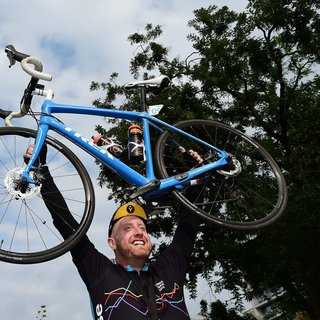Triathlon cycling guide
You never forget how to ride a bike. The trick for a triathlon is turning your leisurely cycling into a race effort. Our top tips will help you build strength, agility and speed.
Tailor training to your fitness level
The amount of training to put in before your triathlon depends on your fitness level and cycling ability.
How long will you train for?
- If you haven’t ridden a bike for years (or ever!) you’ll need to start your training regime at least four months in advance. You should build up your mileage gradually so you don’t over exercise or get injured. This will help you get a good base fitness and build your stamina up from there.
- You’ve got moderate fitness if you’ve been cycling intermittently over the years. This may be cycling to work in the summer or regular Sunday rides with the family. This means you’ll likely have some basic fitness and confidence for cycling, so two to three months should be enough time to prepare.
- If you’ve got good fitness – you cycle regularly throughout the year, either to work everyday or you race at the weekends. You’ll already have a good training schedule and be fit enough to tackle your triathlon without too much extra training.
Eat right
Cycling burns more than 300 calories an hour, so your appetite increases as you burn that energy off. To look after your body, you need to eat well to give your muscles fuel, repair any muscle or tissue damage, and replace lost electrolytes and nutrients.
Your triathlon training diet should include:
- Carbohydrates: a high carb diet is recommended for anyone involved in an endurance sport such as cycling. Carbs give you the bulk of your energy.
- Fats: fats help breakdown food to give you enough energy and help store sugar and energy. Around 20-30% of your diet should be fats.
- Proteins: proteins are the building blocks of tissue repair. It’s important for cyclists to eat 15-20% of protein in their diet to help rebuild muscle and tissue fibres.
- Vitamins and minerals: alongside other micro-nutrients, vitamins and minerals have an important part to play. Eating fresh fruit and veg will keep your immune system healthy and help with tissue repair.
- Water: this is just as important as food. Even when you feel you don't need it, drink plenty of water. It’s just as important to keep your fluid up after exercise to help you recover.
Keep your bike in good condition
- If you've already got a bike, you're already halfway there. But if your bike’s been gathering dust and you are taking it out for training, take it for a thorough service.
- Once you’ve got your bike in good working order, don’t forget all the kit. You’ll need a good quality helmet and cycling clothes.
- Make sure you stay safe by getting reflective clothing and lights if you’re training after dark.
Structure your sessions
When you are training, it’s important to structure your sessions properly to get the most out of them and prevent injury.
- Warm up for at least 10 minutes at the start of each session. Don’t forget to stretch after your session as well. The rounded shoulder position through cycling can lead to overstretched upper back muscles and a tight chest. Spending a few minutes stretching after each ride will help prevent this from happening.
- Plan recovery time into your schedule. Whilst you need to cycle at least twice a week to retain your cycle strength, give yourself time in between to recover.
- Between two and four outings a week is enough. Aim for a long ride every week or fortnight for more than an hour. This will build up your endurance.
Know the course
- Get to know the route. For example, at Blenheim you’ll have to cycle more than one lap of the course. Remember to count how many laps you’ve done to avoid cycling more than you need to.
- There are no drink stations on the bike course at Blenheim. You might want to buy and prepare a drink before the race starts. Place it ready on your bike in the transition area.
- If it’s wet on the day, the bike course at Blenheim can get very slippery. Make sure you’re extra careful if the weather’s poor.
Blenheim Palace Triathlon: cycling course
Our Blenheim course video details what one lap of the bike course is like. Make sure you watch it ahead of race day. We’ve also included hints and tips along the way to help you plan your training.

